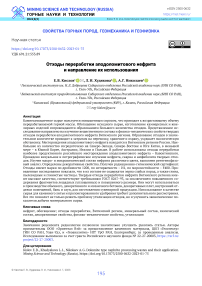Отходы переработки аподоломитового нефрита и направление их использования
Автор: Кислов Е.В., Худякова Л.И., Николаев А.Г.
Журнал: Горные науки и технологии @gornye-nauki-tekhnologii
Рубрика: Свойства горных пород. Геомеханика и геофизика
Статья в выпуске: 3 т.8, 2023 года.
Бесплатный доступ
Камнесамоцветное сырье пользуется повышенным спросом, что приводит к возрастающему объему перерабатываемой горной массы. Обогащение исходного сырья, изготовление камнерезных и ювелирных изделий сопровождаются образованием большого количества отходов. Представленное исследование направлено на изучение вещественного состава и физико-механических свойств твердых отходов переработки аподоломитового нефрита Витимского региона. Образование отходов в значительном количестве приводит к затратам на перевозку, хранение и охрану, ухудшает экологическую обстановку. Месторождения аподоломитового нефрита находятся в Витимском регионе России. Наибольшее их количество сосредоточено на Северо-Западе, Северо-Востоке и Юге Китая, в меньшей мере - в Южной Корее, Австралии, Италии и Польше. В работе использованы отходы переработки наиболее продуктивного российского месторождения аподоломитового нефрита - Кавоктинского. Проведено визуальное и петрографическое изучение нефрита, скарна и амфиболита твердых отходов. Изучен макро- и микрохимический состав нефрита различного цвета, выполнен рентгенофазовый анализ. Определены декоративные свойства. Получен радиационно-гигиенический сертификат. Отходы имеют марки по дробимости 1200, по истираемости - И1, по морозостойкости - F400. Проведенные исследования показали, что в их составе не содержатся зерна слабых пород, а также глина, пылевидные и глинистые частицы. Твердые отходы переработки нефрита Витимского региона имеют высокое качество, соответствуют требованиям ГОСТ 8267-93, за исключением повышенного содержания фрагментов лещадных (уплощенных) и повышенного размера. Они могут использоваться в производстве обычного, декоративного и мозаичного бетонов, декоративных плит, внутренней отделки помещений, бань и саун, для изготовления сувенирной продукции. Использование в качестве сырья для каменного литья и пролонгированного удобрения требует дополнительного рассмотрения. Все это позволит не только решить проблему утилизации отходов, но и улучшить экономические показатели добычи минерального сырья.
Нефрит, обогащение, отходы переработки, витимский регион, минеральный состав, химический состав, декоративные свойства, физико-механические свойства, утилизация
Короткий адрес: https://sciup.org/140301763
IDR: 140301763 | УДК: 691.21:553.89 | DOI: 10.17073/2500-0632-2023-01-75
Текст научной статьи Отходы переработки аподоломитового нефрита и направление их использования
Камнесамоцветное сырье пользуется повышенным спросом, что приводит к возрастающему объему перерабатываемой горной массы. Обогащение исходного сырья, изготовление камнерезных и ювелирных изделий сопровождаются образованием большого количества отходов, представленных двумя видами. Это твердые обломки и обрезки вмещающих пород и некондиционного нефрита, полученные в результате получения сортового камня и изготов- ления изделий, а также шламы, образованные при резке и обработке, – смесь воды, абразивного материала и мелких частиц камня. Объем их составляет 10–35 % исходного сырья. Постоянно увеличивающийся объем отходов приводит к возрастающим затратам на их перевозку, хранение и охрану от расхищения. Отходы оказывают негативное воздействие на окружающую среду и здоровье человека [1–4]. Поэтому необходима утилизация таких отходов с получением товарной продукции.
2023;8(3)
Kislov E. В. et al. Dolomite type nephrite processing wastes and their application
Шлам используют в основном для производства цементов, бетонов и керамики, улучшая их показатели. В состав цементов вводится гранитный [5], мраморный [6–8] шлам. Он заменяет природный песок в составе цементных растворов [9]. Вводят шлам в состав глиняной массы для производства керамических материалов [10–13]. Отходы переработки мрамора, преимущественно твердые, используются для получения извести [14]. Отходы гранита используют для стабилизации рыхлых грунтов [15], а мраморную пыль – глинистых [16]. Обломки и обрезки используются в производстве искусственного декоративного камня для укладки пешеходных тротуаров [17], полов жилых и промышленных зданий [18].
Все вышеперечисленные примеры касаются отходов переработки гранита и мрамора. Единичные работы посвящены возможности использования некондиционного апосерпентинитового нефрита [19, 20]. Отходы переработки аподоломитового нефрита до сих пор не рассматривались, несмотря на интенсивное его использование.
По состоянию на 01.01.2022 Государственным балансом запасов в России учитываются 26 месторождений нефрита. В 2021 г. разрабатывалось 7 месторождений в Бурятии, включая Кавоктинское, Нижне-Олломинское, Сергеевскую залежь, Хайтин-ское аподоломитового нефрита. Из других месторождений аподоломитового нефрита Воймаканское в Бурятии подготавливалось к отработке, Удоканское в Забайкальском крае и Буромское в Бурятии разведывались. В нераспределенном фонде месторождений аподоломитового нефрита нет. Все они находятся в Витимском нефритоносном районе. Наиболее крупное Кавоктинское – на 01.01.2022 запасы по С2 346,81 т, добыто в 2021 г. 70,36 т нефрита, или 28,58 % добычи России.
За рубежом большинство месторождений апо-доломитового нефрита находятся в Китае. Наиболее крупные известные месторождения в Северо-Западном Китае. В Синцзян-Уйгурском автономном районе находится отрабатываемый уже 6 тысячелетий нефритоносный пояс Хотан как с коренными месторождениями [21–23], среди которых наиболее известен и изучен Аламас [24, 25], так и знаменитыми россыпными месторождения Юрункаш – «река белого нефрита» и Каракаш – «река черного нефрита» [26–28]. К поясу Хотан с востока примыкают нефритоносные районы Алтынтаг [29, 30] и Южный Алтынтаг [31-32]. Еще восточнее находятся Голмуд и другие месторождения провинции Цинхай [33, 34]. Ряд месторождений находится в Северо-Восточном Китае: Тели в провинции Хэйлунцзян [35–37], Паньши в провинции Гирин [38], Сюань и Санпиюй в провинции Ляонин [39, 40]. В Восточном Китае известно месторождение Сяомэйлин в провинции Цзянсу [41, 42]. В Южном Центральном Китае находятся месторождения Луаньчуань в провинции Хэнань [43, 44] и Дахуа в Гуанси-Джуанском автономном районе [45–47]. В Южном Западном Китае – месторождения Лунси в провинции Сычуань [48] и Лодянь в провинции Гуйжоу [49].
В других странах следует отметить месторождение Чунчон в Южной Корее [50, 51], район Коуэлл на полуострове Эйр в Южной Австралии [52, 53], месторождение Альпе Мастабия (Вал Маленко) в Ломбардии, Италия [54] , месторождение Злоты Сток в Нижней Силезии, Польша [55–57].
Цель данной работы – изучение физико-механических характеристик твердых отходов переработки аподоломитового нефрита и определение направлений их использования.
Материалы и методы
Объект исследований – твердые отходы, образованные в процессе обогащения аподоломитового нефрита Витимского региона. Отходы обогащения нефрита Кавоктинского месторождения предоставлены ООО «Ориентал Вэй».
Отбор образцов для лабораторного исследования проводился точечным методом. По разложенным на горизонтальной поверхности частям партии намечалась квадратная сетка. Из середины клеток сетки отбирались навески образцов. Для максимальной представительности всех разновидностей отходов переработки нефрита из партии выбрано 20 навесок образцов общим весом 200 кг для дальнейшего лабораторного исследования. Представительные образцы отобраны для детального вещественного исследования (рис. 1).
Отходы переработки нефрита исследовались на соответствие требованиям ГОСТ 8267–93 «Щебень и гравий из плотных горных пород для строительных работ. Технические условия» и ГОСТ 8269.0–97 «Щебень и гравий из плотных горных пород и отходов промышленного производства для строительных работ. Методы физико-механических испытаний».
Методика включала в себя минералого-петрографическое исследование, выполнение химического анализа, определение декоративных свойств, проведение физико-механических испытаний отходов и сравнение полученных данных с требуемыми показателями ГОСТа.
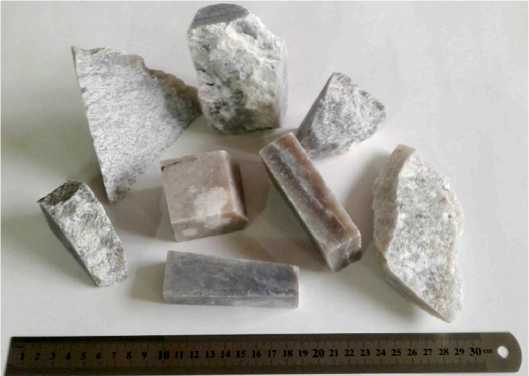
2023;8(3)
Были проведены визуальное петрографическое и минералогическое определение твердых отходов с отбором представительных образцов, измерение размеров и описание формы при помощи мерной ленты; взвешивание портативными электронными весами, определение излома, твердости по шкале Мооса, выявление трещиноватости, диагностика карбонатных минералов 5%-ным раствором соляной кислоты, петрографическое изучение шлифов под поляризационным микроскопом ПОЛАМ Л-213 в ГИН СО РАН, Улан-Удэ.
Силикатный анализ выполнен в ЦКП «Геоспектр» ГИН СО РАН, Улан-Удэ, на спектрофотометре UNICO 1201 (United Products and Instruments, США), работающем в спектральном интервале 315–1000 нм; атомно-абсорбционном спектрофотометре SOLAAR-6М («Unicam», Англия) с соответствующим программным обеспечением. Также использовались атомно-абсорбционный, пламенно-фотометрический, гравиметрический и титрометрический методы, весы электронные ВСЛ-200/0,1А (ЗАО «ВЕС-СЕРВИС», Санкт-Петербург, Россия) с диапазоном взвешивания от 0,01 до 205 г.
Содержания рассеянных элементов определены на масс-спектрометрической системе высокого разрешения HR ICP-MS ELEMENT2 (ThermoFinnigan) для мультиэлементного анализа геологического материала в ЦКП «Геоаналитик» ИГГ УрО РАН, Екатеринбург. Контроль качества получаемых результатов осуществлялся путем параллельных анализов внутренних све-рочных проб и стандартных образцов горных пород (образцы СГ-1А, СГД-1А, BCR-2). В течение анализа серии проб измерение стандартного образца – BCR2 (U.S. Geological Survey) – проводилось с периодичностью 1:5–1:10.
Оптические свойства – прозрачность, цвет, оптические эффекты, включения, изучались с помощью бинолупы МБС-10 и 20-кратной геммологической лупы 20-кратного увеличения в КФУ, Казань. При определении цвета, оттенков, тона и насыщенности использовались шкала цвета по системе GIA и требования ТУ 117-3-0761-7-00 для определения тона и насыщенности цвета образцов. Исследования проводились методом оптической абсорбционной спектроскопии. Оптические спектры поглощения записывались на стандартизированном спектрофотометре МСФУ-К. Регистрация оптических спектров поглощения производилась в интервале длин волн 400–800 нм с шагом 1 нм. Для объективного измерения и описания окраски образцов была использована методика расчета координат цветности по международной колориметрической системе XYZ. Все колориметрические результаты по интерпретации оптических спектров поглощения минералов были вынесены на стандартный цветовой треугольник международной комиссии по освещению (МКО-1931). Колориметрические параметры исследуемых минералов по международной системе CIE Lab рассчитывались с использованием специализированной программы «Спектр». Координаты цвета с помощью специальной таблицы переводились в системы GIA, которые используются для оценки цвета. Все экспериментальные исследования проводились при комнатной температуре. С каждого образца снималось по 5 спектров.
Физико-механические свойства определялись в БИП СО РАН, Улан-Удэ, в соответствии с требованиями ГОСТ 8267–93 «Щебень и гравий из плотных горных пород для строительных работ. Технические условия» и ГОСТ 8269.0–97 «Щебень и гравий из плотных горных пород и отходов промышленного производства для строительных работ. Методы физико-механических испытаний». Из отходов выбирали фракцию 40–70 мм для определения зернового состава. Фракцию более 70 мм дробили на щековой дробилке. Доведение проб отходов до постоянной массы, определение влажности осуществлялись в шкафу сушильном ШСУ-М1 (ОАО «Электроприбор», Санкт-Петербург, Россия) с температурой нагрева от 50 до 300 ºС и скоростью нагрева до максимальной температуры не более 120 мин. При выполнении гранулометрического анализа использовался стандартный набор сит. Взвешивание осуществлялось на весах электронных МК-15.2-А22/10540 (ЗАО «Мас-са-К», Санкт-Петербург, Россия). Рентгенофазовый анализ проводился на порошковом автоматическом дифрактометре D8 Advance фирмы BrukerAXS (Germany) с соответствующим программным обеспечением со скоростью угломера 2º в минуту в интервале от 5 до 70º. При проведении механических испытаний использовался испытательный гидравлический пресс ПГМ-500 (ООО «СКБ Стройприбор», Челябинск, Россия) с диапазоном нагрузок до 50 т и скоростью перемещения плиты 10 ± 1 мм мин-1. При определении истираемости использовался барабан полочный КП 123 (ООО «Новое дело», Санкт-Петербург, Россия) диаметром 700, длиной 500 мм, снабженный на внутренней поверхности полкой шириной 100 мм.
Радиационно-гигиеническая оценка выполнена в соответствии с требованиями ГОСТ 30108–2016 «Материалы и изделия строительные. Определение удельной эффективной активности естественных радионуклидов». Измерение эффективной удельной активности природных радионуклидов отходов переработки нефрита проведено в Испытательном лабораторном центре Федерального бюджетного учреждения здравоохранения «Центр гигиены и эпидимиологии в Республике Бурятия» на комплексе универсальном спектрометрическом УСК «Гамма-плюс».
Результаты
Партия твердых отходов представлена угловатыми изометричными до уплощенных обломками, обрезками неправильной формы светло-окрашенного нефрита-сырца. Размер 75 % блоков – от 4 до 12 см по наибольшему измерению, 25 % – от 12 до 15 см. Окраска камня однородная до неоднородной, иногда пятнистая, полосчатая, светло-салатная, серовато-белая, зачастую с голубоватым оттенком, светло-серая, темно-серая, бурая (медовая), редко местами светло-зе-
ГОРНЫЕ НАУКИ И ТЕХНОЛОГИИ https://mst.misis.ru/
2023;8(3) Kislov E. В. et al. Dolomite type nephrite processing wastes and their application леная, зачастую с бурыми каемками прокрашивания по трещинам и поверхностям блока. Местами блоки содержат визуально различимые изометричные зерна тремолита, кальцита, эпидота, хлорита, черные и изумрудно-зеленые вкрапления, дендриты черных гидроксидов марганца и хлопьеобразные агрегаты бурых гидроксидов железа; покрыты белыми матовыми корочками с дендритами черных гидроксидов марганца; по трещинам также отмечаются дендриты черного гидроксида марганца, белые пленки кальцита и бурые – гидроксидов железа. Ряд блоков содержат участки белых матовых тремолит-кальцитовых скарнов, разнообразных по окраске метасоматизирован-ных амфиболитов. Некоторые блоки полностью сложены скарнами и амфиболитами.
При увеличении бинокулярного микроскопа в нефрите отмечаются включения отдельных кристаллов и агрегатов кальцита и широкопризматического тремолита, дендриты гидроксидов марганца, хлопьевидные агрегаты гидроксидов железа, прожилки кальцит-тремолитового скарна. На свежих сколах обнаруживаются неровные, занозистые, раковистые изломы.
Структура нефрита под петрографическим микроскопом – практически мономинеральный агрегат кристаллов и тончайших волокон преимущественно тремолитового амфибола с характерной для нефритов спутанно-волокнистой (фибробластовой) структурой, с размером отдельных волокон от нескольких микрон до 0,1 × 0,5 мм. Форма агрегатов в основном параллельно-волокнистая, веерообразная и войлокоподобная. Участками в нефрите наблюдаются включения отдельных кристаллов и агрегатов кальцита, широкопризматического тремолита изометричной или вытянутой формы с размером зерен до 1–10 мм. Нефрит принимает неоднородную полировку, местами отмечается значительная шагрень. Участки нефрита с включениями других минералов и их агрегатных скоплений не принимают полировки, матовые, шероховатые. Просвечиваемость по краю штуфа на глубину до 5 см.
В скарне тремолит представлен несколькими разновидностями: плотный фарфоровидный, состоящий из мельчайших, бесформенных лучистых агрегатов с просечками, расплывчатыми агрегатами тонкодисперсного кальцита, следами призматиче- ских кристаллов тремолита; крупные бесформенные выделения с реликтами расщепленного призматического тремолита, замещенного тонковолокнистым тремолитом; мелкозернистый разноориентированный тремолит с величиной зёрен от 0,01 × 0,03 до 0,6 х 1,3 мм. Встречаются чечевицеобразные агрегаты тонкозернистого кальцита в различной пропорции с тремолитом. В другом случае многочисленные одиночные зерна, метельчатые, радиальнолучистые агрегаты тремолита с апатитом чередуются с нефритовидными участками, сложенными микро- и тонкозернистым тремолитом. Встречаются также диопсид, плагиоклаз.
Основной минерал амфиболита – тремолит до актинолита. Тремолит находится в крупных зёрнах кальцита в виде тонких длинных игольчатых призм, протыкающих минерал-хозяин параллельно друг другу, беспорядочных срастаний с неровными, извилистыми поверхностями. Разнозернистый актинолит образует агрегаты с редким кальцитом, сростками призматического эпидота, иногда слагающего радиально-лучистые срастания, калиевый полевой шпат образует редкие небольшие угловатые интерстиции. Зерна кальцита содержат включения доломита, эпидота, хлорита, кварца до 30 % площади минерала-хозяина, зерна цоизита и тонко-листоватого хлорита, образующего также причудливые, иногда обширные пятнообразные агрегаты среди зёрен кальцита. Ксеноморфные зёрна кварца насыщены ромбическими, игольчатыми кристаллами тремолита и/или эпидота, занимающими до 25 % площади минерала-хозяина. В некоторых случаях преобладает плагиоклаз, по которому развиваются зернистые агрегаты эпидота и клиноцоизита, иногда образующих самостоятельные интерстициальные агрегаты, в том числе с калиевым полевым шпатом. Встречаются также апатит, сфен и циркон.
Содержание макро- и микрокомпонентов в нефрите разной цветовой гаммы из твердых отходов представлено в табл. 1 и 2.
Минеральный состав твердых отходов подтверждается результатами рентгенофазового анализа (рис. 2).
На рентгенограмме основные рефлексы принадлежат минералам: тремолиту, диопсиду, хлориту, тальку и кальциту.
Таблица 1
Химический состав нефрита
|
Проба |
Содержание |
||||||||||||||||
|
% |
г/т |
||||||||||||||||
|
SiO2 |
TiO2 |
Al 2 O 3 |
Fe 2 O 3 |
FeO |
MnO |
MgO |
CaO |
Na2O |
K2O |
P 2 O 5 |
п.п.п |
Сумма |
F |
Cr |
Co |
Ni |
|
|
KC-6 |
58,2 |
<0,02 |
0,3 |
<0,1 |
0,20 |
0,04 |
25,77 |
12,50 |
0,08 |
0,06 |
<0,1 |
2,72 |
99,87 |
0 |
<5 |
6 |
9,5 |
|
KC-7 |
57,5 |
<0,02 |
0,6 |
<0,1 |
0,16 |
0,02 |
24,98 |
12,92 |
0,08 |
0,04 |
<0,1 |
2,9 |
99,2 |
0 |
<5 |
9,5 |
8 |
|
KC-8 |
56,8 |
<0,02 |
0,7 |
<0,1 |
0,22 |
0,03 |
25,36 |
13,15 |
0,10 |
0,07 |
<0,1 |
2,28 |
98,71 |
0,32 |
9 |
9,8 |
8 |
Примечание: здесь и далее – анализы нефрита – КС-6 – бурого, КС-7 – салатного, КС-8 – белого.
2023;8(3)
tremolite
I diopside
chlorite
talc
4:
calcite
30 40 50 60
Таблица 2
Содержание рассеянных элементов в нефрите, г/т
|
Элемент |
КС-6 |
КС-7 |
КС-8 |
Элемент |
КС-6 |
КС-7 |
КС-8 |
|
Li |
4 |
7 |
6 |
Te |
< 0,01 |
< 0,01 |
0,026 |
|
Be |
11 |
17 |
9 |
Cs |
1,8 |
2,1 |
0,7 |
|
Sc |
1 |
1 |
0,6 |
Ba |
6 |
5 |
8 |
|
Ti |
50 |
80 |
18 |
La |
0,2 |
0,4 |
0,35 |
|
V |
8 |
17 |
8 |
Ce |
0,47 |
0,8 |
0,59 |
|
Cr |
2,4 |
4,7 |
15 |
Pr |
0,06 |
0,1 |
0,07 |
|
Mn |
180 |
80 |
140 |
Nd |
0,25 |
0,41 |
0,3 |
|
Co |
4 |
6 |
5 |
Sm |
0,06 |
0,09 |
0,07 |
|
Ni |
11 |
6 |
9 |
Eu |
0,01 |
0,02 |
0,018 |
|
Cu |
4,1 |
6 |
50 |
Gd |
0,065 |
0,094 |
0,069 |
|
Zn |
14 |
20 |
14 |
Tb |
0,01 |
0,014 |
0,01 |
|
Ga |
0,8 |
2,4 |
0,9 |
Dy |
0,07 |
0,09 |
0,06 |
|
Ge |
0,5 |
0,5 |
0,6 |
Ho |
0,015 |
0,02 |
0,012 |
|
As |
90 |
86 |
80 |
Er |
0,043 |
0,058 |
0,033 |
|
Se |
0,2 |
0,17 |
0,15 |
Tm |
0,006 |
0,009 |
0,0036 |
|
Rb |
2,4 |
2,9 |
2,3 |
Yb |
0,04 |
0,05 |
0,02 |
|
Sr |
70 |
60 |
60 |
Lu |
0,006 |
0,008 |
0,0028 |
|
Y |
0,4 |
0,6 |
0,5 |
Hf |
0,041 |
0,06 |
0,06 |
|
Zr |
2,1 |
2,7 |
2,8 |
Ta |
0,019 |
0,06 |
< 0,001 |
|
Nb |
0,06 |
0,37 |
0,12 |
W |
16 |
30 |
40 |
|
Mo |
0,22 |
0,16 |
0,6 |
Tl |
0,013 |
0,012 |
0,005 |
|
Ag |
< 0,0004 |
0,027 |
0,079 |
Pb |
4 |
8 |
12 |
|
Cd |
0,05 |
0,05 |
0,09 |
Bi |
< 0,0005 |
0,057 |
0,065 |
|
Sn |
0,11 |
0,2 |
0,28 |
Th |
0,008 |
0,14 |
0,03 |
|
Sb |
0,08 |
0,18 |
0,24 |
U |
0,026 |
0,6 |
0,047 |
Рис. 2. Рентгенограмма отходов переработки нефрита
ГОРНЫЕ НАУКИ И ТЕХНОЛОГИИ https://mst.misis.ru/
2023;8(3) Kislov E. В. et al. Dolomite type nephrite processing wastes and their application
При визуальном описании выделены следующие цветовые характеристики: основной цвет, оттенок, тон, насыщенность с двумя основными разновидностями. Белый от чисто белого до слабо насыщенного сероватого или желтовато-коричневатого, при окислении железа до коричневого (медового) – пример на рис. 3. Салатный (зеленоватый) от голубовато- до желто-зеленоватого, при окислении железа до коричневого (медового) – пример на рис. 4.
Таким образом, основные цветовые виды - белый, встречаются серый с бледно-зеленым оттенком, яркие светло-синевато-зеленые и синевато-зеленые тона. Характеристика рисунка - однородный, коричневые каемки прокрашивания. Редко включения призматического тремолита, реже кальцита и диопсида белого цвета, заметные благодаря спайности.
Общая особенность оптических спектров поглощения нефритов - наличие широкой полосы поглощения в ближней инфракрасной области в райо- не 990 нм (рис. 5). При исследовании конфигурации данной линии и результатов химических анализов нефритов было выявлено, что данная полоса связана со спин-разрешенными переходами 5T2 (5D) ^ 5E (5D) в ионах Fe2+ в позициях М1, М2, М3, которые замещают Mg2+. Полосы поглощения в районе 440 нм и 650 нм в спектре изучаемого нефрита обусловлены разрешенными по спину переходами из основного состояния 4A2g (4F) на более высокие энергетические уровни - 4T1g (4F) и 4T2g (4F) соответственно [58, 57].
Удельная эффективная активность природных радионуклидов отходов переработки нефрита составила менее 50 Бк/кг.
Поскольку отходы представляют собой остатки от распиловки размером более 40 мм, в качестве щебня можно использовать только фракцию 40–70 мм, остальную часть необходимо подвергнуть дроблению. Фракционный состав дробленых отходов представлен на рис. 6.
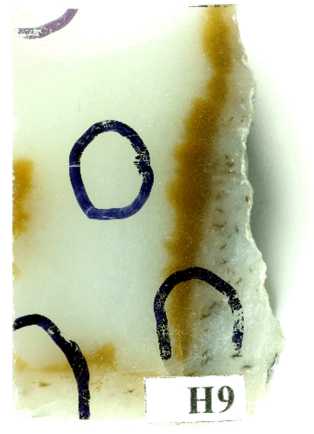
Рис. 3. Нефрит Н9 белый w с коричневыми каемками br и корочкой выветривания с черными гидроксидами марганца
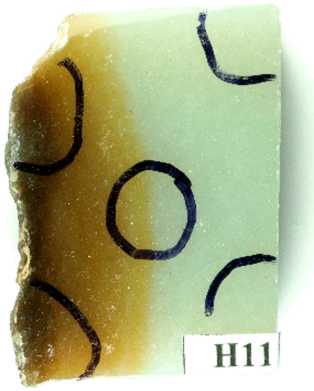
Рис. 4. Нефрит Н11 синевато-зеленый bG светлый l, умеренно сильная насыщенность света mst, корочка прокрашивания коричневая Brn (от светлой l до чрезвычайно темной exdk с сильной насыщенностью света st)
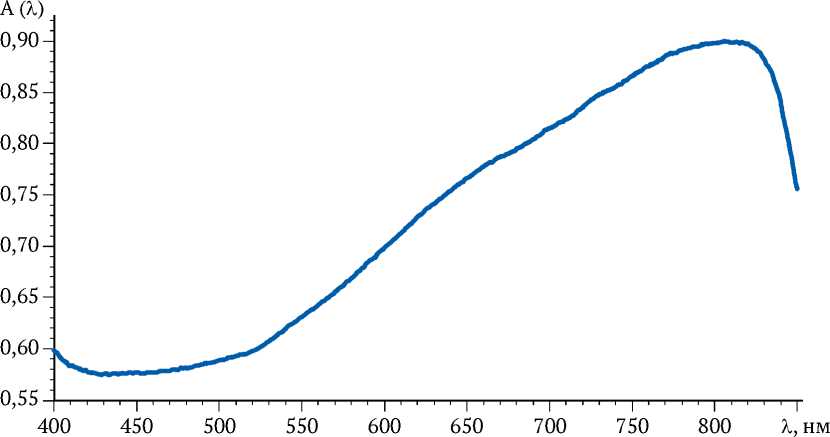
Рис. 5. Оптический спектр белого нефрита Н9. Lab 55,0938: -5,4096: -5,7374 (CIE Lab)
2023;8(3)
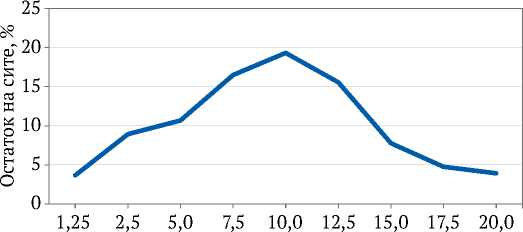
Размер сит, мм
Рис. 6. Распределение щебня по размерам сит
Как показывают полученные данные, наибольшее количество дробленых отходов (62 %) имеет размеры от 5 до 15 мм, фракция менее 5 мм составляет 21,5 %.
Обладая спутанно-волокнистой микроструктурой и высокой вязкостью, нефрит очень тяжело дробится. В результате наблюдается высокий процент зерен игловатой и лещадной форм. Данный показатель составляет 23,4 %, что относит щебень из отходов переработки нефрита к третьей группе щебня согласно ГОСТ 8267–93.
Отходы имеют марки по дробимости 1200, по истираемости – И1, по морозостойкости – F400. Проведенные исследования показали, что в их составе не содержатся зерна слабых пород, а также глина, пылевидные и глинистые частицы. Результаты исследований и соответствие твердых отходов переработки нефрита Витимского региона требованиям ГОСТ 8267–93 сведены в табл. 3.
Обсуждение
В результате изучения вещественного состава твердых отходов переработки нефрита Витимского региона вредных компонентов и примесей – минералов, химических макро- и микрокомпонентов не обнаружено. Декоративные свойства (окраска, рисунок, просвечиваемость, принятие полировки, дефекты) соответствуют существующим стандартам.
Удельная эффективная активность природных радионуклидов отходов переработки нефрита менее 50 Бк/кг, что соответствует нормам НРБ-99/2009, ГОСТ 8267–93 и 1-му классу безопасности. Это позволяет использовать их для всех видов строительных работ в качестве поделочного и облицовочного камня.
Отходы имеют марки по дробимости 1200, по истираемости – И1, по морозостойкости – F400. Проведенные исследования показали, что в их составе не содержатся зерна слабых пород, а также глина, пылевидные и глинистые частицы. Твердые отходы переработки нефрита Витимского региона имеют высокое качество, соответствуют требованиям ГОСТ 8267–93, за исключением повышенного содержания фрагментов лещадных (уплощенных) и повышенного размера. Их реализация как щебня возможна по соглашению сторон.
Отходы переработки нефрита имеют высокое качество и после дробления могут использоваться в качестве щебня для проведения строительных работ. Наряду с изготовлением обычного бетона можно получать декоративный и мозаичный бетоны для отделки и облицовки стен и полов. Возможно получение декоративных плит для пола на основе цементных и полимерных вяжущих композиций. Это обусловлено соответствием отходов требованиям ГОСТ 9479–2011 «Блоки из
Таблица 3
Физико-механические показатели отходов переработки нефрита
|
№ п/п |
Показатель |
Отходы переработки нефрита |
Требования ГОСТ 8267–93 |
|
1 |
Полные остатки на контрольных ситах, % по массе |
98,73 |
d от 90 до 100 |
|
48,34 |
0,5(d + D) от 30 до 60 |
||
|
6,10 |
D до 10 |
||
|
0,32 |
1,25D до 0,5 |
||
|
2 |
Содержание зерен пластинчатой (лещадной) и игловатой формы, % по массе |
36,6 |
|
|
3 |
Марка по дробимости |
1200 |
|
|
4 |
Марка по истираемости |
И1 |
|
|
5 |
Содержание зерен слабых пород, % по массе |
0 |
Менее 5 |
|
6 |
Морозостойкость |
F400 |
|
|
7 |
Содержание пылевидных и глинистых частиц, % по массе |
0 |
Менее 1 |
|
8 |
Содержание глины в комках, % по массе |
0 |
Менее 0,25 |
|
9. |
Наличие вредных компонентов и примесей |
нет |
|
|
10 |
Устойчивость против всех видов распада (потеря массы при распаде, %) |
0 |
Менее 3 |
|
11 |
Истинная плотность, г/см3 |
2,8426 |
|
|
12 |
Средняя плотность, г/см3 |
2,8995 |
|
|
13 |
Насыпная плотность, кг/м3 |
1314,29 |
|
|
14 |
Влажность, % |
0,083 |
|
|
15 |
Водопоглощение, % |
0,1937 |
ГОРНЫЕ НАУКИ И ТЕХНОЛОГИИ https://mst.misis.ru/
2023;8(3) Kislov E. В. et al. Dolomite type nephrite processing wastes and their application горных пород для производства облицовочных, архитектурно-строительных, мемориальных и других изделий» и ГОСТ 24099–2013 «Плиты декоративные на основе природного камня. Технические условия».
Кроме того, отходы переработки нефрита можно использовать как облицовочный материал для внутренней отделки помещений (прихожих, ванн). Поскольку они имеют высокую плотность (2900 кг/м3), прочность (М1200), низкое водопоглощение (0,2 %), устойчивы к воздействию агрессивных сред, перепадам температур, имеют температуру плавления порядка 1250 ºС и низкую теплопроводность, они пригодны для облицовки бань и саун.
Отходы переработки нефрита – ценный материал для изготовления сувенирной продукции. Отходы могут быть использованы в качестве сырья для каменного литья и пролонгированного удобрения, особенно для территорий с недостатком кальция и магния из-за преобладающего развития гранитов, таких как Бурятия.
Заключение
Отходы переработки нефрита имеют высокое качество, за небольшим исключением соответствуют требованиям российских стандартов. Они могут использоваться в производстве щебня, в том числе для производства обычного, декоративного и мозаичного бетонов. В составе цементных и полимерных вяжущих композиций они пригодны для получения декоративных плит. В качестве самостоятельного материала могут применяться для внутренней отделки помещений. Также это ценное сырье для изготовления сувенирной продукции. Они могут использоваться в качестве сырья для каменного литья и пролонгированного удобрения, особенно для территорий с недостатком кальция и магния из-за преобладающего развития гранитов, таких как Бурятия. Все это позволит не только решить проблему утилизации отходов, но и улучшить экономические показатели добычи минерального сырья.
2023;8(3)
Khudyakova L. I., Kislov E. V., Paleev P. L., Malyshev A. V. Comprehensive use of substandard nephrite. Bulletin of the Tomsk Polytechnic University. Geo Assets Engineering . 2020;331(8):68-76. (In Russ.) https://doi.or g/10.18799/24131830/2020/8/2769
ГОРНЫЕ НАУКИ И ТЕХНОЛОГИИ https://mst.misis.ru/
2023;8(3) Kislov E. В. et al. Dolomite type nephrite processing wastes and their application
Platonov A. N., Taran M. N., Balitsky V. S. The nature of the color of gems . Moscow: Nedra Publ. House; 1984. 196 p. (In Russ.)
Sviridov D. T., Sviridova R. K., Smirnov Yu. F. Optical spectra of transition metal ions in crystals . Moscow: Nauka Publ. House; 1976. 266 p. (In Russ.)
2023;8(3)
Список литературы Отходы переработки аподоломитового нефрита и направление их использования
- Emmanuel A. Y., Jerry C. S., Dzigbodi D. A. Review of environmental and health impacts of mining in Ghana. Journal of Health and Pollution. 2018;8(17):43-52. https://doi.org/10.5696/2156-9614-8.17.43
- Jain M. K., Das A. Impact of mine waste leachates on aquatic environment: A review. Current Pollution Reports. 2017;3(1):31-37. https://doi.org/10.1007/s40726-017-0050-z
- Wellen C., Shatilla N. J., Carey S. K. The influence of mining on hydrology and solute transport in the Elk Valley, British Columbia, Canada. Environmental Research Letters. 2018;13(7):074012. https://doi.org/10.1088/1748-9326/aaca9d
- Strzałkowski P. Characteristics of waste generated in dimension stone processing. Energies. 2021;14(21):7232. https://doi.org/10.3390/en14217232
- Medina G., Sáez del Bosque I. F., Frías M., et al. Mineralogical study of granite waste in a pozzolan/Ca(OH)2 system: Influence of the activation process. Applied Clay Science. 2017;135:362-371. https://doi.org/10.1016/j.clay.2016.10.018
- Prošek Z., Nezerka V., Tesárek P. Enhancing cementitious pastes with waste marble sludge. Construction and Building Materials. 2020;255:119372. https://doi.org/10.1016/j.conbuildmat.2020.119372
- Wang T., Yang W., Zhang J. Experimental studies on mechanical properties and microscopic mechanism of marble waste powder cement cementitious materials. Crystals. 2022;12(6):868. https://doi.org/10.3390/cryst12060868
- Ahmed A., Abbas S., Abbass W., et al. Potential of waste marble sludge for repressing alkali-silica reaction in concrete with reactive aggregates. Materials. 2022;15(11):3962. https://doi.org/10.3390/ma15113962
- Moreira P. I., de Oliveira Dias J., de Castro Xavier G., et al. Ornamental stone processing waste incorporated in the production of mortars: Technological influence and environmental performance analysis. Sustainability. 2022;14(10):5904. https://doi.org/10.3390/su14105904
- Gadioli M. C. B., Ponciano V. M., Bessa B. H. R., et al. Characterization of ornamental stones wastes for use in ceramic materials. Materials Science Forum. 2019;958:129-134. https://doi.org/10.4028/www.scientific.net/MSF.958.129
- Xavier G. C., Azevedo A. R. G., Alexandre J., et al. Determination of useful life of red ceramic parts incorporated with ornamental stone waste. Journal of Materials in Civil Engineering. 2019;31(2). https://doi.org/10.1061/(ASCE)MT.1943-5533.0002590
- Munir M. J., Kazmi S. M. S., Wu Y.-F., et al. Thermally efficient fired clay bricks incorporating waste marble sludge: An industrial-scale study. Journal of Cleaner Production. 2018;174:1122-1135. https://doi.org/10.1016/j.jclepro.2017.11.060
- Ahmad S., Shah M. U. H., Ullah A., at el. Sustainable use of marble waste in industrial production of fired clay bricks and its employment for treatment of flue gases. ACS Omega. 2021;6:22559−22569. https://doi.org/10.1021/acsomega.1c02279
- Soltan A. M., Taman Z., El-Kaliouby B. Recycling of ornamental stones hazardous wastes. Natural Resources. 2011;2(4):244−249. https://doi.org/10.4236/nr.2011.24031
- Abdelkader H. A. M., Ahmed A. S. A., Hussein M. M. A., et al. An experimental study on geotechnical properties and micro-structure of expansive soil stabilized with waste granite dust. Sustainability. 2022;14(10):6218. https://doi.org/10.3390/su14106218
- Ibrahim H. H., Alshkane Y. M., Mawlood Y. I., at el. Improving the geotechnical properties of high expansive clay using limestone powder. Innovative Infrastructure Solutions. 2020;5(3):112. https://doi.org/10.1007/s41062-020-00366-z
- Carvalho E. A. S., Vilela N. F., Monteiro S. N., et al. Novel artificial ornamental stone developed with quarry waste in epoxy composite. Materials Research. 2018;21(1):e20171104. https://doi.org/10.1590/19805373-MR-2017-1104
- Silva F. S., Ribeiro C. E. G., Rodriguez R. J. S. Physical and mechanical characterization of artificial stone with marble calcite waste and epoxy resin. Materials Research. 2018;21(1). https://doi.org/10.1590/1980-5373MR-2016-0377
- Худякова Л. И., Кислов Е. В., Палеев П. Л., Малышев А. В. Комплексное использование некондиционного нефрита. Известия Томского политехнического университета. Инжиниринг георесурсов. 2020;331(8):68−76. https://doi.org/10.18799/24131830/2020/8/2769
- Khudyakova L. I., Kislov E. V., Paleev P. L., Kotova I. Yu. Nephrite-bearing mining waste as a promising mineral additive in the production of new cement types. Minerals. 2020;10(5):394. https://doi.org/10.3390/min10050394
- Liu Y., Zhang R., Zhang Zh., et al. Mineral inclusions and SHRIMP U-Pb dating of zircons from the Alamas nephrite and granodiorite: Implications for the genesis of a magnesian skarn deposit. Lithos. 2015;212-215:128-144. https://doi.org/10.1016/j.lithos.2014.11.002
- Zhang X., Shi G., Zhang X., Gao G. Formation of the nephrite deposit with five mineral assemblage zones in the Central Western Kunlun Mountains, China. Journal of Petrology. 2022;63(11):egac117. https://doi.org/10.1093/petrology/egac117
- Nangeelil K., Dimpfl P., Mamtimin M., et al. Preliminary study on forgery identification of Hetian Jade with Instrumental Neutron Activation Analysis. Applied Radiation and Isotopes. 2023;191:110535. https://doi.org/10.1016/j.apradiso.2022.110535
- Liu Y., Deng J., Shi G. H., et al. Chemical Zone of Nephrite in Alamas, Xinjiang, China. Resource Geology. 2010;60(3):249-259. https://doi.org/10.1111/j.1751-3928.2010.00135.x
- Liu Y., Deng J., Shi G., et al. Geochemistry and petrology of nephrite from Alamas, Xinjiang, NW China. Journal of Asian Earth Sciences. 2011;42(3):440-451. https://doi.org/10.1016/j.jseaes.2011.05.012
- Jing Y., Liu Y. Genesis and mineralogical studies of zircons in the Alamas, Yurungkash and Karakash Rivers nephrite deposits, Western Kunlun, Xinjiang, China. Ore Geology Reviews. 2022;149:105087. https://doi.org/10.1016/j.oregeorev.2022.105087
- Liu Y., Deng J., Shi G., Sun X., Yang L. Geochemistry and petrogenesis of placer nephrite from Hetian, Xinjiang, Northwest China. Ore Geology Reviews. 2011;41(1):122-132. https://doi.org/10.1016/j.oregeorev.2011.07.004
- Liu Y., Zhang R.-Q., Maituohuti A., et al. SHRIMP U-Pb zircon ages, mineral compositions and geochemistry of placer nephrite in the Yurungkash and Karakash River deposits, West Kunlun, Xinjiang, northwest China: Implication for a Magnesium Skarn. Ore Geology Reviews. 2016;72(1):699-727. https://doi.org/10.1016/j.oregeorev.2015.08.023
- Jiang Y., Shi G., Xu L., Li X. Mineralogy and geochemistry of nephrite jade from Yinggelike deposit, Altyn Tagh (Xinjiang, NW China). Minerals. 2020;10(5):418. https://doi.org/10.3390/min10050418
- Liang H., Shi G., Yuan Y., et al. Polysynthetic twinning of diopsides in the Niewang and Tatliksu nephrite deposits, Xinjiang, China. Minerals. 2022;12(12):1575. https://doi.org/10.3390/min12121575
- Gao K., Shi G., Wang M. et al. The Tashisayi nephrite deposit from South Altyn Tagh, Xinjiang, northwest China. Geoscience Frontiers. 2019;10(4):1597-1612. https://doi.org/10.1016/j.gsf.2018.10.008
- Liu X., Gil G., Liu Y. Timing of formation and cause of coloration of brown nephrite from the Tiantai Deposit, South Altyn Tagh, northwestern China. Ore Geology Reviews. 2021;131:103972. https://doi.org/10.1016/j.oregeorev.2020.103972
- Yu H. Y., Wang R. C., Guo J. C., et al. Color-inducing elements and mechanisms in nephrites from Golmud, Qinghai, NW China: Insights from spectroscopic and compositional analyses. Journal of Mineralogical and Petrological Sciences. 2016;111(5):313-325. https://doi.org/10.2465/jmps.151103
- Yu H. Y., Wang R. C., Guo J. C., et al. Study of the minerogenetic mechanism and origin of Qinghai nephrite from Golmud, Qinghai, Northwest China. Science China Earth Sciences. 2016;59:1597-1609. https://doi.org/10.1007/s11430-015-0231-8
- Gao S., Bai F., Heide G. Mineralogy, geochemistry and petrogenesis of nephrite from Tieli, China. Ore Geology Reviews. 2019;107:155-171. https://doi.org/10.1016/j.oregeorev.2019.02.016
- Xu H., Bai F. Origin of the subduction-related Tieli nephrite deposit in Northeast China: Constraints from halogens, trace elements, and Sr isotopes in apatite group minerals. Ore Geology Reviews. 2022;142:104702. https://doi.org/10.1016/j.oregeorev.2022.10470
- Xu H., Bai F., Jiang D. Geochemical characteristics and composition changes of tremolite at various stages in the mineralization process of nephrite from Tieli, Heilongjiang, Northeastern China. Arabian Journal of Geosciences. 2021;14:204. https://doi.org/10.1007/s12517-021-06578-6
- Bai F., Li G., Lei J., Sun J. Mineralogy, geochemistry, and petrogenesis of nephrite from Panshi, Jilin, Northeast China. Ore Geology Reviews. 2019;115:103171. https://doi.org/10.1016/j.oregeorev.2019.103171
- Zhang C., Yu X., Jiang T. Mineral association and graphite inclusions in nephrite jade from Liaoning, northeast China: Implications for metamorphic conditions and ore genesis. Geoscience Frontiers. 2019;10(2):425-437. https://doi.org/10.1016/j.gsf.2018.02.009
- Zheng F., Liu Y., Zhang H.-Q. The petrogeochemistry and zircon U-Pb age of nephrite placer deposit in Xiuyan, Liaoning. Rock and Mineral Analysis. 2019;38(4):438-448. (In Chinese). https://doi.org/10.15898/j.cnki.l1-2131/td.201807310089
- Li P., Liao Z., Zhou Zh., Wu Q. Evidences from infrared and Raman spectra: Xiaomeiling is one reasonable provenance of nephrite materials used in Liangzhu Culture. Spectrochimica Acta Part A: Molecular and Biomolecular Spectroscopy. 2021;261:120012. https://doi.org/10.1016/j.saa.2021.120012
- Li P., Liao Z., Zhou Zh. The residual geological information in Liangzhu jades: Implications for their provenance. Proceedings of the Geologists’ Association. 2022;133(3):256-268. https://doi.org/10.1016/j.pgeola.2022.04.003
- Chen D., Yang Y., Qiao B., et al. Integrated interpretation of pXRF data on ancient nephrite artifacts excavated from Tomb No. 1 in Yuehe Town, Henan Province, China. Heritage Science. 2022;10:1. https://doi.org/10.1186/s40494-021-00642-w
- Ling X.-X., Schmädicke E., Li Q.-L., et al. Age determination of nephrite by in-situ SIMS U-Pb dating syngenetic titanite: A case study of the nephrite deposit from Luanchuan, Henan, China. Lithos. 2015;220-223:289-299. https://doi.org/10.1016/j.lithos.2015.02.019
- Bai B., Du J., Li J., Jiang B. Mineralogy, geochemistry, and petrogenesis of green nephrite from Dahua, Guangxi, Southern China. Ore Geology Reviews. 2020;118:103362. https://doi.org/10.1016/j.oregeorev.2020.103362
- Yin Z., Jiang C., Santosh M., et al. Nephrite jade from Guangxi province, China. Gems and Gemology. 2014;50(3):228-235. https://doi.org/10.5741/GEMS.50.3.228
- Zhong Q., Liao Z., Qi L., Zhou Zh. Black nephrite jade from Guangxi, Southern China. Gems and Gemology. 2019;55(2):198-215. https://doi.org/10.5741/GEMS.55.2.198
- Wang W., Liao Z., Zhou Z., et al. Gemmological and mineralogical characteristics of nephrite from Longxi, Sichuang Province. Journal of Gems & Gemmology. 2022;24(1):20-27. (In Chinese). https://doi.org/10.15964/j.cnki.027jgg.2022.01.003
- Wang L., Lin J. H., Ye T. P., et al. Discussing the coloration mechanism of Luodian Jade from Guizhou. Open Access Library Journal. 2020;7:e6364. https://doi.org/10.4236/oalib.1106364
- Feng Y., He X., Jing Y. A new model for the formation of nephrite deposits: A case study of the Chuncheon nephrite deposit, South Korea. Ore Geology Reviews. 2022;141:104655. https://doi.org/10.1016/j.oregeorev.2021.104655
- Yui T.-F., Kwon S.-T. Origin of a dolomite-related jade deposit at Chuncheon, Korea. Economic Geology. 2002;97(3):593-601. https://doi.org/10.2113/gsecongeo.97.3.593
- Nichol D. Two contrasting nephrite jade types. The Journal of Gemmology. 2000;27(4):193-200.
- Tan T. L., Ng N. N., Lim N. C. Studies on nephrite and jadeite jades by Fourier transform infarred (FTIR) and Raman spectroscopic techniques. Cosmos. 2013;9(1):47-56. https://doi.org/10.1142/S0219607713500031
- Adamo I., Bocchio R. Nephrite jade from Val Malenco, Italy: Review and Update. Gems and Gemology. 2013;49(2):98-106. https://doi.org/10.5741/GEMS.49.2.98
- Korybska-Sadło I., Gil G., Gunia P., et al. Raman and FTIR spectra of nephrites from the Złoty Stok and Jordanów Śląski (the Sudetes and Fore-Sudetic Block, SW Poland). Journal of Molecular Structure. 2018;1166:40-47. https://doi.org/10.1016/j.molstruc.2018.04.020
- Gil G., Barnes J. D., Boschi C. Nephrite from Złoty stok (Sudetes, SW Poland): petrological, geochemical, and isotopic evidence for a dolomite-related origin. The Canadian Mineralogist. 2015;53:533-556. https://doi.org/10.3749/canmin.1500018
- Gil G., Bagiński B., Gunia P., et al. Comparative Fe and Sr isotope study of nephrite deposits hosted in dolomitic marbles and serpentinites from the Sudetes, SW Poland: Implications for Fe-As-Au-bearing skarn formation and post-obduction evolution of the oceanic lithosphere. Ore Geology Reviews. 2020;118:103335. https://doi.org/10.1016/j.oregeorev.2020.103335
- Платонов А. Н., Таран М. Н., Балицкий В. С. Природа окраски самоцветов. М.: Недра; 1984. 196 с.
- Свиридов Д. Т., Свиридова Р. К., Смирнов Ю. Ф. Оптические спектры ионов переходных металлов в кристаллах. М.: Наука, 1976. 266 с.

